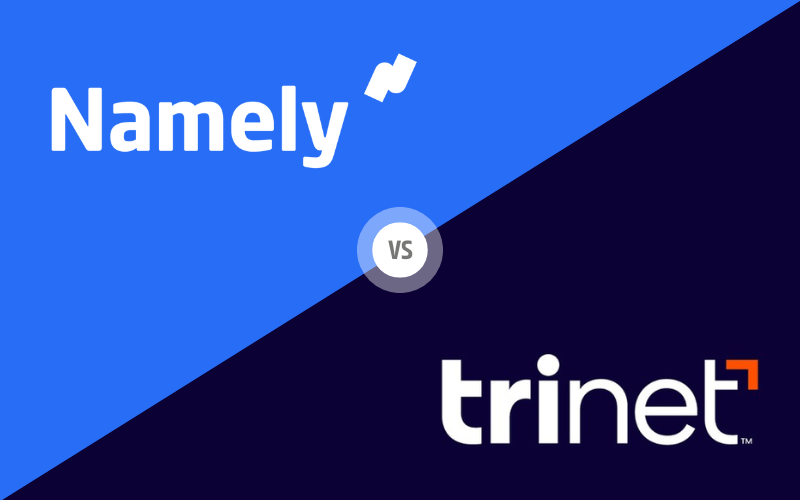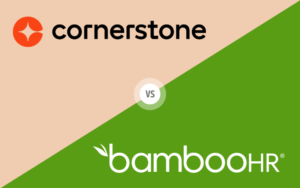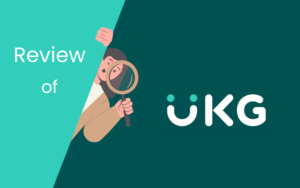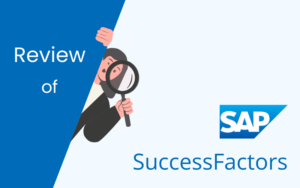When it comes to choosing the right human capital management (HCM) system, the comparison between Namely vs TriNet offers significant insights into which platform might best suit your organizational needs. Both Namely and TriNet are prominent players in the HCM field, each offering unique strengths that cater to different types of businesses, from small enterprises to large corporations. This blog post delves into a detailed comparison across multiple dimensions including user interface, core HR functions, payroll management, and more, to help you determine which system – Namely or TriNet – is the optimal choice for enhancing your company’s human resource operations.
Table of Contents
User Interface and User Experience
When comparing the user interface (UI) and user experience (UX) of Namely and TriNet, it’s crucial to understand how each platform’s design and functionality cater to different organizational needs. Both systems aim to streamline HR tasks, but they do so with distinct approaches tailored to varying business sizes and complexities.

Namely User Interface and User Experience
Namely features a modern, user-friendly interface that appeals primarily to mid-sized businesses with under 1000 employees. The platform offers an “elegant user interface” and an “integrated platform” designed to enhance the experience for both HR professionals and employees.
Key Features of Namely UI/UX:
- Customization: Namely emphasizes configurability, allowing significant tailoring of the platform to meet specific business needs.
- Ease of Use: The interface is designed for simplicity and efficiency, enabling quick navigation and operation.
- Social Feed: Incorporates a built-in newsfeed to foster better interaction and keep the workforce connected and motivated.
- Mobile Optimization: Offers a mobile app, ensuring that HR tasks can be managed effectively on the go.
Namely is often praised for its user-friendly design and customization options. However, larger organizations with more complex HR needs might find its capabilities somewhat limiting.
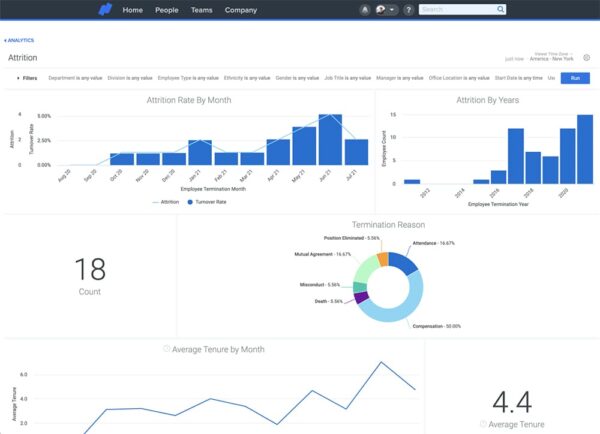
TriNet User Interface and User Experience
TriNet’s UI is designed to support a comprehensive range of HR functions, potentially making it more suitable for organizations with complex HR management needs. However, specific details about TriNet’s interface and user experience are less readily available from official sources.
Key Features of TriNet UI/UX:
- Functionality: Provides a wide array of HR functions, though the exact nature and organization of these features within the interface require further verification.
- Professional Design: While the interface complexity is not explicitly confirmed, TriNet likely focuses on functionality to support extensive management needs.
- Reporting Capabilities: TriNet is known for offering robust analytics and reporting tools, though specific details about the user interface for these features are not provided in the available sources.
- Scalability: The platform is designed to support business growth, though the exact nature of this scalability in terms of UI/UX needs further confirmation.
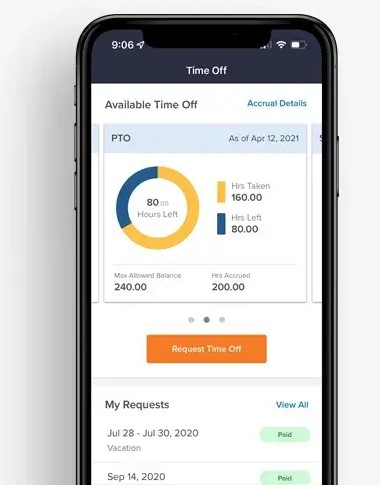
Comparison and Conclusion
The choice between Namely and TriNet should be based on a careful assessment of each platform’s strengths and how they align with your organization’s specific requirements.
Namely is best suited for mid-sized businesses (under 1000 employees) that value a clean, straightforward interface that employees can quickly adopt. Its user-centric design focuses on enhancing day-to-day operations and includes features that promote user engagement and satisfaction. The platform’s emphasis on personalization and scalability makes it adaptable to growing businesses within its target range.
TriNet, while less information is available about its specific UI/UX features, appears to be tailored for organizations that need a robust HR management tool. Its interface likely offers the detailed control necessary to manage a wide range of HR functions effectively, though this complexity may require more time for users to fully navigate and utilize.
In summary
Both Namely and TriNet offer compelling features, but your choice will depend heavily on organizational size, complexity of HR needs, and the importance of user interface and experience in your HR solutions. Namely offers simplicity and ease of use, making it ideal for mid-sized businesses or those with straightforward HR requirements. TriNet likely provides more comprehensive functionality, potentially suiting larger organizations or those with complex HR tasks.
Choosing the right platform involves weighing these factors against your current and future needs to determine which solution not only fits your immediate requirements but also supports your long-term HR strategy. It’s recommended to request demos or trials of both platforms to get a firsthand experience of their interfaces and functionalities before making a decision.
Core HR Functions
When evaluating the core HR functions of Namely vs TriNet, it’s important to consider how each platform supports the fundamental human resources tasks essential for smooth business operations. Both platforms offer robust solutions, but their features and capabilities cater to different organizational requirements.

Namely Core HR Functions
Namely provides a comprehensive suite of HR tools designed to support small to medium-sized businesses. It simplifies many routine HR tasks with a focus on user-friendliness and integration.
Key Features of Namely Core HR Functions:
- Employee Self-Service: Allows employees to manage their personal information, benefits, and compliance documents, empowering them and reducing administrative burdens on HR staff.
- HR Compliance: Offers built-in compliance tools to help businesses stay up-to-date with regulations and avoid penalties.
- Centralized HR Database: A unified database for all HR information, ensuring consistency and easy accessibility.
- Onboarding and Employee Lifecycle Management: Streamlined processes for onboarding new hires and managing them throughout their tenure.
- Performance Management: Tools for setting goals, tracking progress, and conducting reviews.
- Time Tracking: Integrated time tracking capabilities for accurate payroll and productivity monitoring.
Namely offers different editions (Namely Now, Namely Plus, Namely Plus People, Namely Complete) catering to various business needs and sizes. The platform has a 7.5/10 likelihood to recommend on TrustRadius.
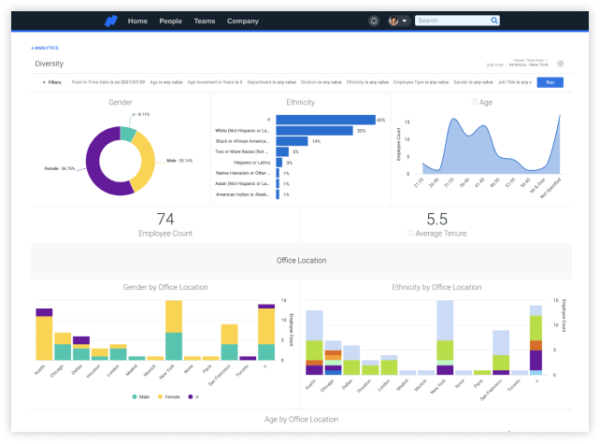
TriNet Core HR Functions
TriNet, geared more towards medium to large-sized businesses, offers an extensive array of core HR functions that are scalable and comprehensive, supporting a wide range of HR needs.
Key Features of TriNet Core HR Functions:
- Extensive Benefits Management: Provides access to premium benefits options that can be tailored to the diverse needs of a larger workforce.
- Payroll Administration: Advanced payroll capabilities, including automatic tax calculations, compliance, and multi-state payroll processing.
- Risk Mitigation: Offers robust risk management tools, including workers’ compensation and safety compliance.
- Strategic HR Consulting: Access to expert advice and HR consulting to help companies navigate complex HR landscapes and plan strategically for growth.
- Technology Platform: A comprehensive platform that integrates various HR functions for streamlined operations.
- Industry-Specific Solutions: Tailored HR solutions designed for specific industries and their unique requirements.
TriNet has a 7.2/10 likelihood to recommend on TrustRadius, reflecting its strong position in the market for larger organizations.
Comparison and Conclusion
The choice between Namely and TriNet for core HR functions largely depends on the size of your business and the complexity of your HR requirements.
Namely is particularly effective for smaller to medium-sized companies seeking a user-friendly and integrated HR system. Its tools are designed to simplify HR management, allowing businesses to focus more on growth and less on administrative tasks. The platform’s intuitive design encourages quick adoption and minimizes the need for extensive training.
TriNet, on the other hand, is ideal for larger companies with more complex HR needs. Its breadth of services covers everything from payroll to compliance and risk management, providing a comprehensive solution that scales with business growth. The level of detail and customization available in TriNet’s services ensures that larger organizations can tailor the platform to their precise needs.
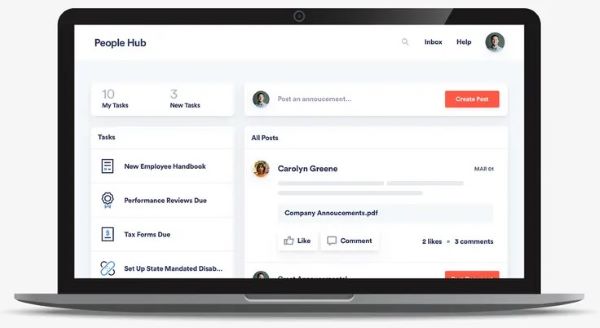
In summary
Selecting between Namely and TriNet should be guided by your organizational needs, the scale at which you operate, and how comprehensive you need your HR functions to be. Namely provides simplicity and ease of use, making it suitable for smaller to medium-sized businesses, while TriNet offers depth and a wide array of features that benefit larger companies. This decision will significantly influence the efficiency of your HR operations and the overall effectiveness of your human resource management strategy, impacting your organization’s long-term success.
Payroll Management
Exploring the payroll management capabilities of Namely vs TriNet is crucial for businesses looking to streamline this essential function. Both platforms offer robust payroll solutions, but their approaches and features serve different organizational needs and scales.

Namely Payroll Management
Namely provides a seamless payroll management system that integrates closely with its other HR functions, making it an ideal choice for small to medium-sized businesses looking for an all-in-one solution.
Key Features of Namely Payroll Management:
- Integrated System: Namely’s payroll is fully integrated with its HR and benefits modules, ensuring that all changes in employee data are automatically updated across the system, reducing errors and saving time.
- User-Friendly Interface: The platform offers a straightforward user interface that simplifies the payroll process, making it accessible for HR administrators without extensive payroll experience.
- Customizable Payroll Reports: Users can generate customizable reports that provide insights into payroll expenses and trends, helping with financial planning and analysis.
- Compliance Support: Namely helps ensure compliance with tax laws and regulations, automatically updating payroll calculations based on the latest tax rates.
- Expense Management: Offers integrated expense tracking and reimbursement functionality.
- E-sign I-9 & W-4: Provides electronic signature capabilities for important tax documents.
Namely’s focus on integration, user-friendliness, and compliance makes its payroll system particularly appealing to smaller organizations that need efficiency without complexity. The platform has a 7.5/10 likelihood to recommend on TrustRadius.
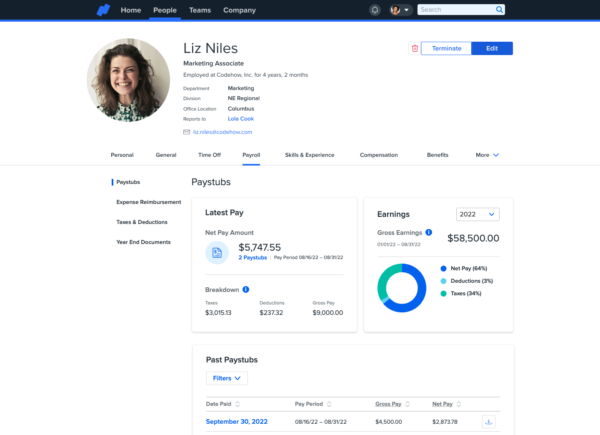
TriNet Payroll Management
TriNet’s payroll management capabilities are designed to accommodate the needs of medium to large-sized businesses, offering advanced features that support complex payroll requirements, including multi-state and international payroll.
Key Features of TriNet Payroll Management:
- Advanced Payroll Processing: TriNet provides sophisticated payroll processing capabilities, including garnishments, benefits deductions, and tax withholdings for multiple states and countries.
- Real-Time Payroll Preview: Allows HR professionals to preview payroll results in real-time, helping to catch errors before processing, thus ensuring accuracy.
- Automated Tax Filing: TriNet automates all aspects of payroll tax filing, from calculations to submissions, significantly reducing the administrative burden and risk of non-compliance.
- Expert Support: TriNet offers access to payroll experts who can provide guidance and help resolve complex payroll issues, which is invaluable for businesses operating in diverse regulatory environments.
- Multi-State and International Payroll: Capable of handling payroll across different states and countries, making it suitable for businesses with a geographically diverse workforce.
- Mobile App: Offers a mobile application for on-the-go payroll management.
TriNet’s comprehensive and expert-backed payroll solutions are well-suited for larger enterprises that face sophisticated payroll challenges. The platform has a 7.2/10 likelihood to recommend on TrustRadius.
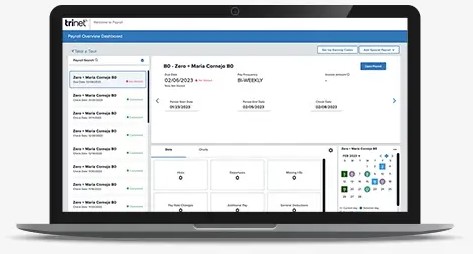
Comparison and Conclusion
When comparing Namely vs TriNet in terms of payroll management, the size and complexity of your business are key determinants in choosing the right platform.
Namely is best suited for SMEs that appreciate a streamlined and integrated approach to payroll. Its system simplifies payroll management by ensuring that all HR-related changes are automatically reflected in the payroll module, thereby enhancing accuracy and compliance with minimal effort. Namely’s user-friendly design also means that less training is required, and smaller HR teams can manage payroll efficiently.
TriNet, however, shines for larger companies with more complex payroll needs. Its ability to handle advanced payroll functions across different states and even internationally makes it a robust choice for enterprises. Additionally, TriNet’s expert support and real-time error checking provide an extra layer of security and accuracy, which is critical for larger organizations with intricate payroll structures.
In summary
Choosing between Namely and TriNet for payroll management involves evaluating your business’s size, payroll complexities, and the level of integration you require with other HR functions. Namely offers a more integrated and straightforward solution ideal for smaller businesses, while TriNet provides a more robust, feature-rich system that can meet the demands of larger, more complex organizations. Both platforms offer essential features like direct deposit and pre-tax deductions. This decision will significantly impact the efficiency and compliance of your payroll operations, ultimately affecting your business’s operational effectiveness and compliance posture.
Time and Attendance Tracking
Time and attendance tracking is a crucial component for efficient workforce management. Evaluating Namely vs TriNet in this aspect reveals how each platform caters to different business sizes and needs, offering tailored solutions to help streamline these processes.

Namely Time and Attendance Tracking
Namely provides a comprehensive solution for time and attendance tracking that is particularly suited for small to medium-sized businesses. Its integration with payroll and HR systems makes it a convenient choice for companies looking for a unified platform.
Key Features of Namely Time and Attendance:
- Seamless Integration: Namely’s time tracking is integrated with its payroll and HR modules, ensuring all time-related data directly updates payroll calculations and employee records.
- Employee Self-Service Portal: Employees can easily clock in and out, view their schedules, and track their hours through a user-friendly interface.
- Mobile App: A robust mobile app allows employees to record time and attendance on the go, which is ideal for remote or field workers.
- Customizable Time-Off Policies: Offers flexible options for setting up and managing time-off policies and accruals.
- Employee Scheduling: Provides tools for creating and managing employee schedules.
Namely’s system is designed to simplify time tracking, reducing errors and administrative overhead. The platform has a 7.5/10 likelihood to recommend on TrustRadius, indicating strong user satisfaction.
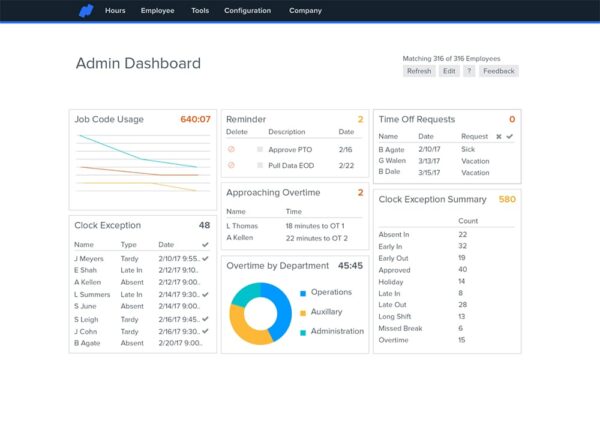
TriNet Time and Attendance Tracking
TriNet offers a robust time and attendance system that caters to businesses of various sizes, from small to large enterprises, with solutions that can handle more complex needs.
Key Features of TriNet Time and Attendance:
- Advanced Scheduling: Supports scheduling needs for various shifts and job types, making it suitable for diverse operations.
- Compliance Features: TriNet helps ensure compliance with labor laws and regulations through automated tracking and reporting features.
- Integration with Payroll Systems: Time tracking integrates seamlessly with payroll and HR functions, ensuring accurate pay calculations and compliance.
- Mobile Time Tracking: Offers mobile capabilities for time tracking, supporting remote and field workers.
- Time-Off Management: Includes tools for managing time-off requests and accruals.
TriNet’s time and attendance solutions are comprehensive, offering features that cater to the needs of organizations of various sizes. The platform has a 7.2/10 likelihood to recommend on TrustRadius.
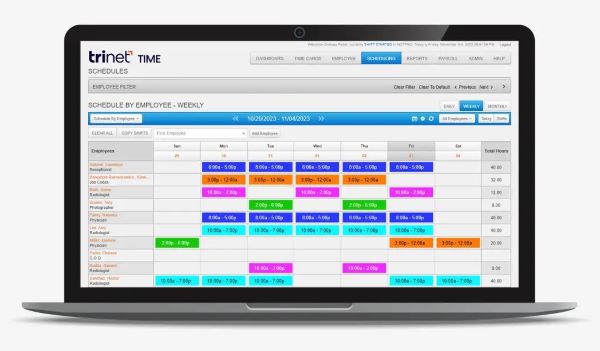
Comparison and Conclusion
Choosing between Namely and TriNet for time and attendance tracking should consider the specific requirements of your organization regarding size, complexity, and industry.
Namely is an excellent option for small to medium-sized companies that need an integrated, straightforward system that employees can use with minimal training. Its ease of use and effective integration help streamline time tracking and payroll processes, reducing administrative burdens and increasing efficiency.
TriNet, while capable of serving businesses of all sizes, may be particularly beneficial for organizations with more complex needs or those anticipating significant growth. Its advanced features support diverse workforces and offer scalability to accommodate expanding businesses.
In summary
The decision to choose Namely or TriNet for time and attendance tracking will largely depend on your business’s size, growth trajectory, and the complexity of your workforce management needs. Both platforms offer mobile time tracking, integration with payroll systems, and customizable time-off policies. Namely’s user-friendly approach may appeal more to smaller businesses, while TriNet’s scalability could be advantageous for growing or larger organizations. Your choice will directly impact how effectively you can manage workforce scheduling, attendance tracking, and overall compliance, which are critical to optimizing operational efficiency and minimizing compliance risks.
Benefits Administration
In the realm of human capital management, efficient benefits administration is crucial for attracting and retaining top talent. Comparing Namely vs TriNet in this domain highlights how each platform accommodates the diverse needs of different organizations, particularly in handling benefits packages and compliance.

Namely Benefits Administration
Namely offers a streamlined benefits administration platform that is especially well-suited for small to medium-sized businesses. It focuses on simplifying the enrollment process and enhancing employee engagement with their benefits packages.
Key Features of Namely Benefits Administration:
- Integrated Platform: Namely integrates benefits administration with other HR functions, providing a unified view of employee data which simplifies management and improves accuracy.
- Employee Self-Service: Employees can easily access and manage their benefits through a user-friendly portal, which increases transparency and satisfaction.
- Customizable Benefits Plans: Namely allows for the customization of benefits packages to meet the specific needs of the company and its employees, enhancing flexibility.
- Compliance Tools: The platform includes tools to help ensure compliance with federal and state regulations, including ACA reporting capabilities.
- E-sign Functionality: Offers e-sign capabilities for I-9 and W-4 forms, streamlining the onboarding process.
Namely’s benefits administration tools are designed to be intuitive and accessible, making them ideal for smaller companies that value simplicity and employee experience. The platform has a 7.5/10 likelihood to recommend on TrustRadius, indicating strong user satisfaction.
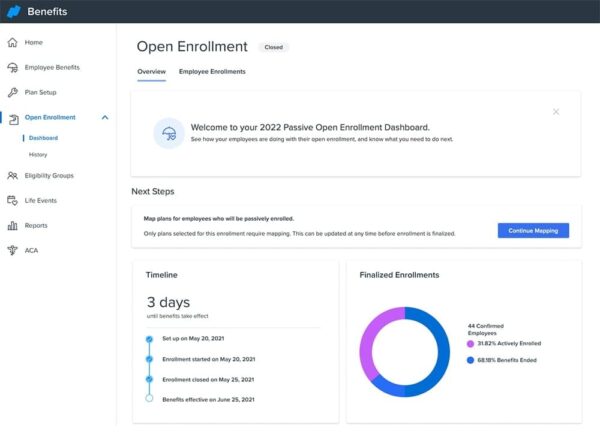
TriNet Benefits Administration
TriNet offers a comprehensive benefits administration solution that caters to businesses of various sizes, from small to large enterprises, with tools that can manage complex benefits packages.
Key Features of TriNet Benefits Administration:
- Extensive Benefits Options: TriNet provides access to a wide range of benefits options, including health, dental, vision, retirement plans, and more, suitable for diverse employee needs.
- Expert Support: TriNet offers the expertise of benefits specialists who can assist with plan selection, compliance, and administration, which is invaluable for companies without a dedicated HR team.
- Automated Enrollment Processes: Streamlines the enrollment process, reducing paperwork and administrative overhead, while ensuring accuracy and compliance.
- Detailed Reporting and Analytics: Advanced tools help track benefits utilization and cost-effectiveness, providing insights that can inform decision-making.
- Employee Self-Service Portal: Allows employees to manage their benefits directly, enhancing engagement and reducing administrative burden.
TriNet’s robust benefits administration capabilities are beneficial for organizations of various sizes that need a broad array of benefits options and expert support. The platform has a 7.2/10 likelihood to recommend on TrustRadius.
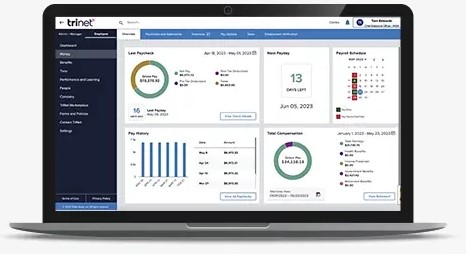
Comparison and Conclusion
When deciding between Namely and TriNet for benefits administration, consider the scale of your operations and the complexity of your benefits needs.
Namely is an excellent choice for small to medium-sized businesses seeking an integrated, straightforward solution that makes benefits administration accessible to all employees. Its platform enhances the employee experience by simplifying access to benefits information and customization options, fostering greater engagement and satisfaction.
TriNet, while capable of serving businesses of all sizes, may be particularly beneficial for organizations with more complex needs or those anticipating significant growth. Its wide range of benefits options and access to expert support ensures that TriNet can accommodate sophisticated requirements of diverse workforces.
In summary
Choosing between Namely and TriNet for benefits administration should align with your organizational needs, employee demographics, and the level of complexity in your benefits packages. Both platforms offer employee self-service portals, compliance tools, and integrated solutions. Namely’s user-friendly approach may appeal more to smaller businesses, while TriNet’s extensive options and scalability could be advantageous for growing or larger organizations. Your choice will significantly impact your ability to manage employee benefits effectively, ensuring both compliance and employee satisfaction, which are crucial for maintaining a competitive edge in talent management.
Performance Management
Performance management systems are essential for fostering employee growth and aligning individual achievements with organizational goals. When comparing the performance management capabilities of Namely vs TriNet, it’s important to understand how each platform supports these objectives through different features and tools suited for varying business sizes.

Namely Performance Management
Namely offers a user-friendly and flexible performance management system that caters especially well to small to medium-sized businesses. Its focus is on simplifying the appraisal process and enhancing communication between managers and employees.
Key Features of Namely Performance Management:
- Customizable Review Templates: Namely allows companies to create and customize their review templates, which can be tailored to different roles or departments, ensuring relevance and effectiveness.
- Goal Setting and Tracking: Employees can set goals and track their progress directly in the system, which managers can monitor and provide feedback on, facilitating continuous performance dialogue.
- Real-Time Feedback: Encourages a culture of feedback by allowing managers and peers to give real-time recognition and constructive criticism, which can be tied to performance reviews.
- Company News Feed: Offers a platform for sharing company updates and achievements, fostering a culture of recognition and engagement.
Namely’s performance management tools are designed to be straightforward yet flexible, making them ideal for SMEs that require a system that is both accessible and capable of adapting to diverse evaluation needs. The platform has a 7.5/10 likelihood to recommend on TrustRadius, indicating strong user satisfaction.
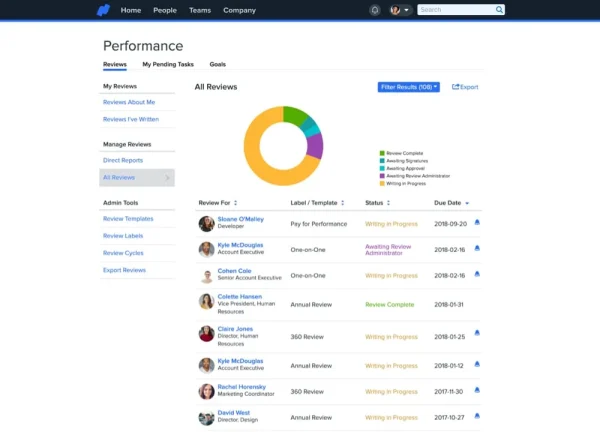
TriNet Performance Management
TriNet provides a robust performance management system suited for businesses of various sizes, from small to large enterprises. It offers features that support detailed performance analyses and employee development.
Key Features of TriNet Performance Management:
- Goal Setting and Tracking: Allows for the creation and monitoring of individual and team goals, aligning them with organizational objectives.
- Performance Review Tools: Offers customizable performance review processes to suit different organizational needs.
- Continuous Feedback Mechanisms: Supports ongoing communication between managers and employees, fostering a culture of continuous improvement.
- Customizable Processes: Allows for the configuration of performance management processes to suit specific organizational structures and cultures.
TriNet’s performance management solutions are designed to meet the demands of organizations looking for scalable and effective performance tracking. The platform has a 7.2/10 likelihood to recommend on TrustRadius.
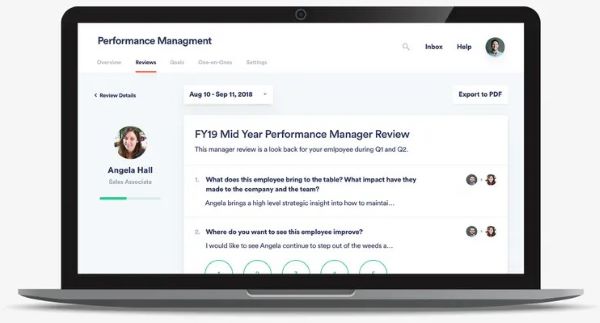
Comparison and Conclusion
The choice between Namely and TriNet for performance management should be guided by your company’s size, the complexity of your performance evaluation needs, and your specific organizational culture.
Namely is well-suited for smaller to medium-sized organizations that value simplicity and flexibility in their performance management system. Its tools facilitate ongoing communication and feedback, which are vital for fostering a supportive and transparent work environment.
TriNet, while capable of serving businesses of all sizes, may be particularly beneficial for organizations with more complex needs or those anticipating significant growth. Its scalable approach to performance management can accommodate the evolving requirements of growing businesses.
In summary
Deciding between Namely and TriNet for performance management involves considering how each platform’s features align with your organizational goals and HR strategies. Both platforms offer customizable review processes, goal setting and tracking, and continuous feedback mechanisms. Namely’s user-friendly approach and integrated company news feed may appeal more to smaller businesses, while TriNet’s scalability could be advantageous for growing or larger organizations. Your choice will significantly influence how effectively you can manage and enhance employee performance, impacting overall productivity and business success.
Talent Management and Recruiting
Effective talent management and recruiting are pivotal for any organization aiming to attract, hire, and retain top talent. When comparing the capabilities of Namely vs TriNet in these crucial HR functions, it’s important to assess how each platform supports the entire recruitment lifecycle and talent management process, catering to different business sizes and needs.

Namely Talent Management and Recruiting
Namely offers a comprehensive talent management and recruiting solution designed to streamline hiring processes and enhance talent retention, making it particularly suitable for small to medium-sized businesses.
Key Features of Namely Talent Management and Recruiting:
- Integrated Applicant Tracking System (ATS): Namely features a built-in ATS that manages the recruitment process from job posting to candidate selection, making it easy to track and manage applications.
- Employee Onboarding: Streamlined onboarding processes ensure that new hires have a smooth transition into the company, with automated task assignments and documentation management.
- Performance Management: Offers tools for setting goals, tracking progress, and conducting performance reviews to support employee development.
- Career Development: Provides features to support employee growth and career progression within the organization.
Namely’s talent management and recruiting tools are user-friendly and integrated, focusing on providing SMEs with the capabilities to manage recruitment and talent development efficiently. The platform has a 7.5/10 likelihood to recommend on TrustRadius, indicating strong user satisfaction.
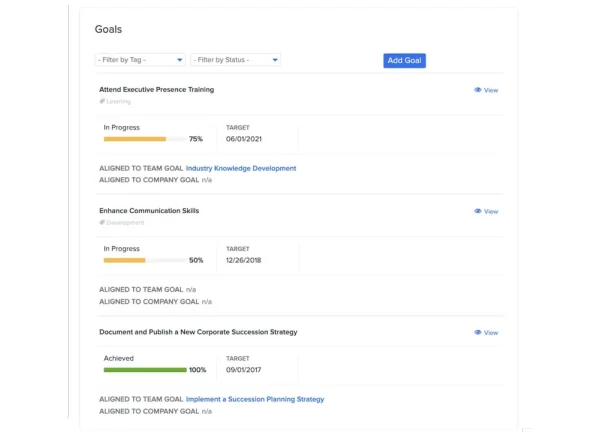
TriNet Talent Management and Recruiting
TriNet offers a robust talent management and recruiting platform that caters to businesses of various sizes, from small to large enterprises, featuring functionalities to handle diverse hiring needs and strategic talent management.
Key Features of TriNet Talent Management and Recruiting:
- Recruiting Services: Supports job posting and candidate tracking to streamline the hiring process.
- Onboarding Tools: Provides resources to facilitate smooth integration of new hires into the organization.
- Performance Management: Includes features for performance tracking and employee development programs.
- Talent Development: Offers tools to support ongoing employee growth and skill enhancement.
TriNet’s talent management and recruiting solutions are designed to meet the needs of organizations with varying HR requirements. The platform has a 7.2/10 likelihood to recommend on TrustRadius.
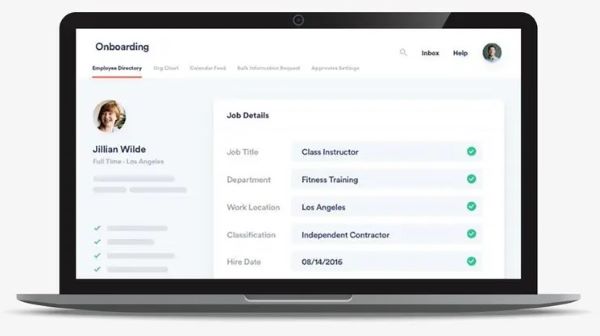
Comparison and Conclusion
Choosing between Namely and TriNet for talent management and recruiting depends significantly on your organization’s size and the complexity of your HR needs.
Namely is ideal for smaller to medium-sized businesses seeking an intuitive and straightforward platform that integrates recruiting and talent management into a cohesive system. Its focus on a streamlined user experience and efficient process management makes it an excellent choice for companies with simpler or moderate-scale recruiting needs.
TriNet, while capable of serving businesses of all sizes, may be particularly beneficial for organizations with more complex needs or those anticipating significant growth. Its scalable approach to talent management and recruiting can accommodate the evolving requirements of growing businesses.
In summary
Deciding between Namely and TriNet for talent management and recruiting should align with your strategic HR goals and operational needs. Both platforms offer integrated ATS, onboarding tools, and performance management features. Namely’s user-friendly approach may appeal more to smaller and medium-sized businesses, while TriNet’s scalability could be advantageous for a wider range of organization sizes. Your choice will significantly influence your ability to attract, develop, and retain skilled employees, directly impacting your organization’s success and growth.
Learning and Development
Learning and development (L&D) programs are critical for enhancing employee skills and fostering a culture of continuous improvement. When assessing the L&D offerings of Namely vs TriNet, it’s essential to consider how each platform supports these initiatives with features that cater to different organizational needs and sizes.

Namely Learning and Development
Namely provides a focused and user-friendly learning and development module suitable for small to medium-sized businesses. Its platform is designed to facilitate accessible and engaging learning opportunities that align with company goals and employee career paths.
Key Features of Namely Learning and Development:
- Integrated Learning Management System (LMS): Namely includes an LMS that integrates seamlessly with its other HR functions, allowing for easy management of learning activities within the same system used for HR and performance management.
- Customizable Learning Paths: Employers can create customized learning paths tailored to the specific roles and career goals of their employees, promoting targeted skill development.
- Diverse Content Support: Offers support for various types of learning content, including videos, quizzes, and interactive modules, designed to enhance employee engagement and retention of material.
- Tracking and Reporting: Provides tools for tracking employee progress and analyzing the effectiveness of training programs, helping HR teams to make informed decisions about future L&D investments.
Namely’s L&D tools are straightforward and effective, making them particularly valuable for SMEs that need to implement scalable and impactful learning solutions. The platform has a 7.5/10 likelihood to recommend on TrustRadius, indicating strong user satisfaction.
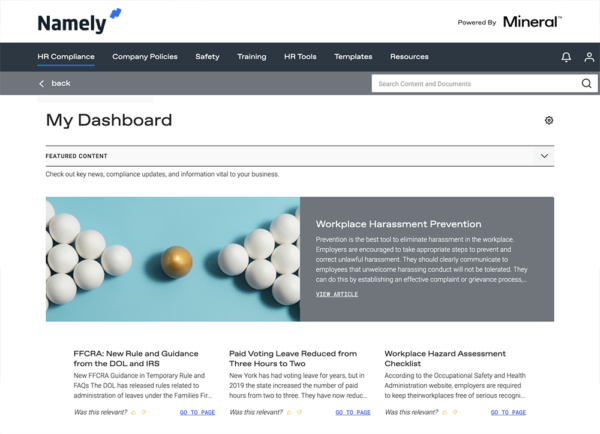
TriNet Learning and Development
TriNet offers a robust learning and development platform that caters to businesses of various sizes, from small to large enterprises, with functionalities to support a wide range of learning initiatives and organizational needs.
Key Features of TriNet Learning and Development:
- Comprehensive LMS: TriNet’s LMS supports both off-the-shelf courses and the ability to upload custom content, accommodating diverse learning needs.
- Skill Gap Analysis: Features tools for assessing skill gaps and aligning learning activities with both individual career aspirations and organizational requirements.
- Custom and Pre-built Courses: Provides access to a library of pre-built courses along with the ability to develop custom courses tailored to specific organizational challenges or opportunities.
- Reporting and Analytics: Includes detailed reporting and analytics features to track learning progress and measure the effectiveness of training programs.
TriNet’s comprehensive L&D capabilities are designed to meet the needs of organizations with varying HR requirements. The platform has a 7.2/10 likelihood to recommend on TrustRadius.
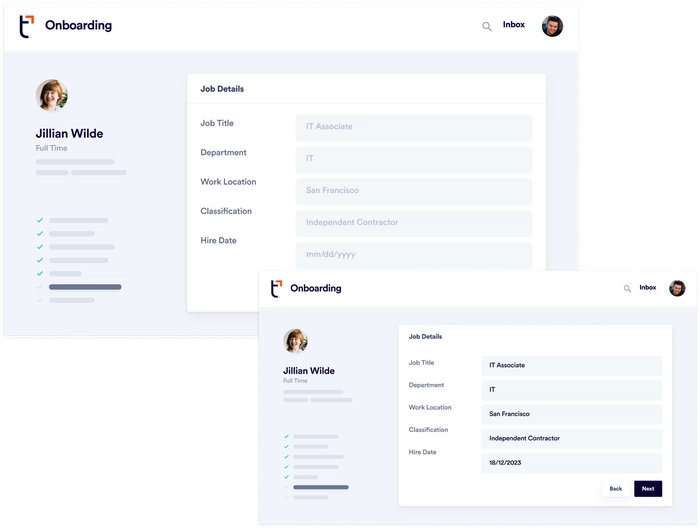
Comparison and Conclusion
The decision between Namely and TriNet for learning and development should be based on your company’s size, the strategic importance of L&D, and the complexity of your learning requirements.
Namely is an excellent choice for smaller to medium-sized businesses that value ease of use and integration, providing essential L&D tools that can be easily managed alongside other HR functions. Its system is geared towards facilitating impactful learning within a streamlined platform.
TriNet, while capable of serving businesses of all sizes, may be particularly beneficial for organizations with more complex needs or those anticipating significant growth. Its advanced features support detailed skills analyses and sophisticated learning modules, catering to diverse educational needs across the organization.
In summary
Selecting between Namely and TriNet for learning and development involves understanding how each platform’s features can support your organizational learning goals and HR strategy. Both platforms offer integrated LMS solutions with customizable learning paths and progress tracking capabilities. Namely’s user-friendly approach may appeal more to smaller and medium-sized businesses, while TriNet’s scalability could be advantageous for a wider range of organization sizes. Your choice will significantly influence your ability to develop a skilled workforce and maintain a competitive edge in your industry.
Reporting and Analytics
In today’s data-driven business environment, robust reporting and analytics capabilities are essential for informed decision-making. When comparing the reporting and analytics features of Namely vs TriNet, it’s important to evaluate how each platform supports these functions to meet the specific needs of different organization sizes.

Namely Reporting and Analytics
Namely offers a streamlined approach to reporting and analytics, designed to cater primarily to small to medium-sized businesses. Its platform provides essential tools that simplify the extraction and interpretation of HR data, aiding in effective decision-making.
Key Features of Namely Reporting and Analytics:
- Customizable Dashboards: Namely allows users to create customized dashboards that highlight key HR metrics, making it easy to access and interpret important data at a glance.
- Standard and Custom Reports: Users can generate standard reports for common HR functions or create custom reports tailored to specific business needs, providing flexibility in data analysis.
- Real-Time Data Access: Provides real-time access to HR data, ensuring that decision-makers have the most current information at their fingertips.
- Data Export Options: Offers the ability to export data in various formats, facilitating seamless integration with other business intelligence tools or systems.
Namely’s reporting and analytics tools are user-friendly and adequately powerful, making them well-suited for SMEs that require straightforward, actionable insights. The platform has a 7.5/10 likelihood to recommend on TrustRadius, indicating strong user satisfaction.
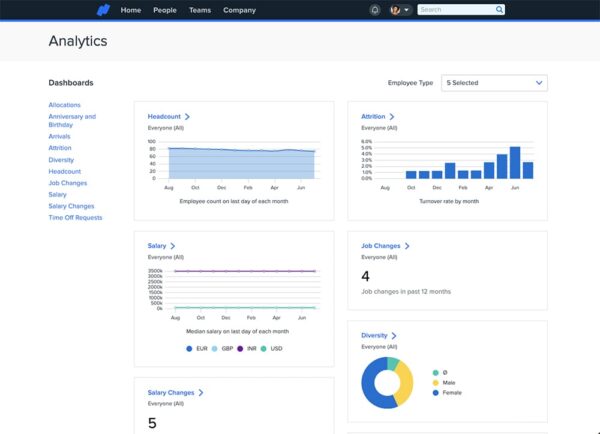
TriNet Reporting and Analytics
TriNet provides comprehensive reporting and analytics capabilities that cater to businesses of various sizes, from small to large enterprises. Its platform includes tools to handle in-depth data analysis and support strategic HR decision-making.
Key Features of TriNet Reporting and Analytics:
- Detailed Reporting: Allows for the generation of detailed reports on a wide range of HR metrics, from payroll and benefits to compliance and employee performance.
- Customizable Analytics: Offers customizable analytics tools to help businesses gain insights into their HR data.
- Data Visualization: Provides tools to visualize data, helping users to easily understand and interpret HR information.
- Integration Capabilities: Supports integration with external business intelligence and analytics systems, enhancing the ability to perform comprehensive, cross-functional analysis.
TriNet’s robust reporting and analytics functions are designed to meet the needs of organizations that demand a deeper understanding of their HR data. The platform has a 7.2/10 likelihood to recommend on TrustRadius.
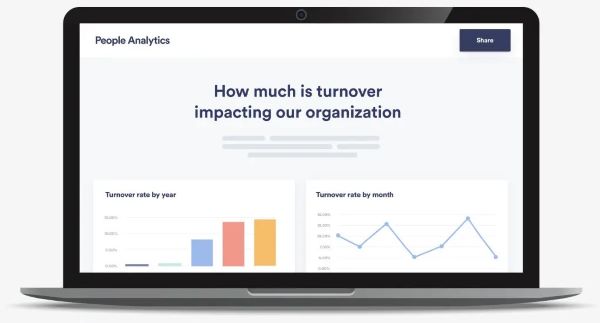
Comparison and Conclusion
Choosing between Namely and TriNet for reporting and analytics depends on the complexity of your data needs and the scale at which your organization operates.
Namely is an excellent option for smaller to medium-sized businesses that need essential reporting capabilities with an emphasis on usability and customization. It provides the necessary tools to support routine decision-making processes, presented in a manner that is easy to understand and act upon.
TriNet, while capable of serving businesses of all sizes, may be particularly beneficial for organizations with more complex needs or those requiring more detailed analytics. Its tools offer deep insights and the ability to integrate with broader data ecosystems, catering to strategic, data-driven HR management.
In summary
The decision to opt for Namely or TriNet in the domain of reporting and analytics should align with your organizational needs for data complexity, user-friendliness, and integration capabilities. Both platforms offer customizable reporting and analytics tools with integration capabilities. Namely’s user-friendly approach may appeal more to smaller and medium-sized businesses, while TriNet’s scalability could be advantageous for a wider range of organization sizes. This choice will significantly impact how effectively you can leverage HR data to drive business success and strategic growth.
Compliance and Security
Compliance and security are critical components of any human capital management (HCM) system. Ensuring that sensitive employee data is protected and that the company adheres to various regulatory requirements is essential. When comparing the compliance and security features of Namely vs TriNet, it’s vital to assess how each platform equips businesses to handle these crucial aspects.

Namely Compliance and Security
Namely provides compliance and security features tailored to meet the needs of small to medium-sized businesses, ensuring that they can manage compliance with ease and confidence.
Key Features of Namely Compliance and Security:
- E-sign Functionality: Namely offers e-sign capabilities for I-9 and W-4 forms, streamlining the onboarding process and ensuring compliance with documentation requirements.
- Automated Tax Filing: Provides automated tax filing and payments, helping businesses stay compliant with tax regulations.
- Regular System Updates: Namely regularly updates its system to reflect the latest legal regulations, helping businesses stay current with compliance requirements.
- Data Protection Measures: While specific details are limited, Namely implements measures to protect sensitive employee data.
Namely’s compliance and security tools are designed to be user-friendly and effective, making them suitable for SMEs that need to ensure they are meeting legal standards without maintaining a large compliance team.
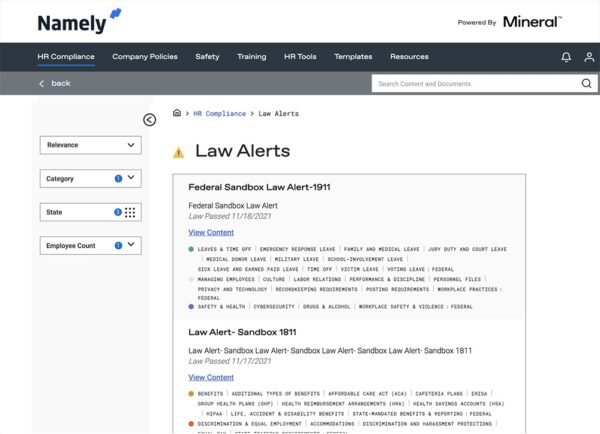
TriNet Compliance and Security
TriNet offers compliance and security features that cater to businesses of various sizes, from small to large enterprises, with tools to support diverse compliance needs.
Key Features of TriNet Compliance and Security:
- Automated Tax Services: Like Namely, TriNet provides automated tax filing and payments, supporting compliance efforts.
- Compliance Support: While specific details are limited in the available sources, TriNet offers tools to help businesses navigate labor laws and industry regulations.
- Data Security Measures: TriNet implements security protocols to protect sensitive data, though specific details are not provided in the search results.
- Scalable Solutions: TriNet’s compliance and security features are designed to scale with businesses as they grow.
TriNet’s compliance and security capabilities are designed to support organizations of various sizes that require a comprehensive approach to compliance management and data security.
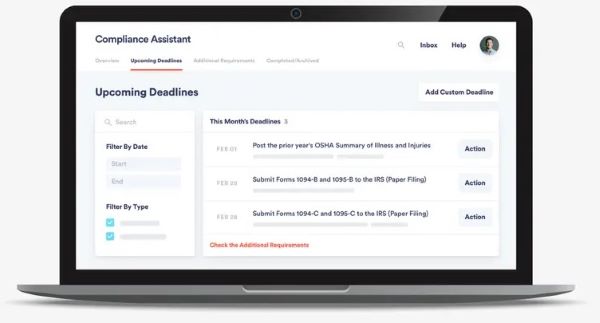
Comparison and Conclusion
Deciding between Namely and TriNet for compliance and security should be based on the specific compliance demands of your industry and the size of your organization.
Namely is well-suited for smaller to medium-sized businesses that need a secure and compliant HCM system. Its user-friendly features like e-sign functionality and automated tax filing provide adequate support for regulatory adherence with less complexity. Namely has a 7.5/10 likelihood to recommend on TrustRadius, indicating strong user satisfaction.
TriNet, while capable of serving businesses of all sizes, may be particularly beneficial for organizations with more complex needs or those requiring more comprehensive compliance support. Its scalable solutions can accommodate growing businesses and their evolving compliance requirements. TriNet has a 7.2/10 likelihood to recommend on TrustRadius.
In summary
Choosing between Namely and TriNet for compliance and security will significantly depend on your organizational needs regarding scale, complexity, and the strategic importance of compliance in your operations. Both platforms offer automated tax services and tools to support compliance efforts. Namely’s user-friendly approach may appeal more to smaller and medium-sized businesses, while TriNet’s scalability could be advantageous for a wider range of organization sizes. This choice will crucially impact your ability to manage compliance and protect employee data, directly influencing your risk management and operational integrity.
Integration and Compatibility
In the evolving landscape of business technology, the ability of an HCM system to integrate seamlessly with existing software and adapt to various business environments is crucial. When evaluating the integration and compatibility capabilities of Namely vs TriNet, it’s important to understand how each platform facilitates these connections to enhance overall business operations.

Namely Integration and Compatibility
Namely is designed to meet the integration needs of small to medium-sized businesses, offering compatibility with a variety of other software systems. Its focus is on providing a user-friendly interface that allows for easy connection with essential business tools.
Key Features of Namely Integration and Compatibility:
- Third-Party Integrations: Namely offers integrations with various third-party applications, enhancing its functionality and allowing businesses to connect with other essential tools.
- API Access: Provides API access to enable custom integrations, allowing businesses to connect and synchronize data with other systems tailored to their specific needs.
- User-Friendly Interface: Namely is praised for its intuitive design, which likely extends to its integration setup and management processes.
- Flexible Connectivity: While specific details are limited, Namely’s platform is designed to work with various HR-related systems, ensuring data flows between platforms.
Namely’s integration features are efficient and sufficient for SMEs that need to maintain streamlined operations across their software ecosystems. The platform has a 7.5/10 likelihood to recommend on TrustRadius, indicating strong user satisfaction.
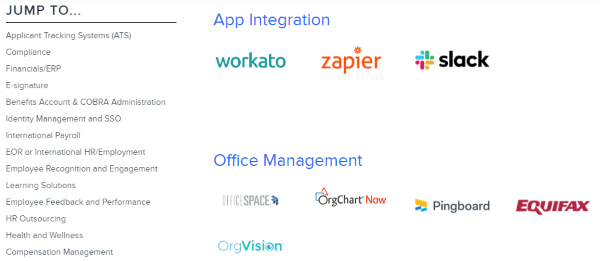
TriNet Integration and Compatibility
TriNet offers a platform with integration and compatibility features that cater to businesses of various sizes, from small to large enterprises. However, specific details about its integration capabilities are limited in the available sources.
Key Features of TriNet Integration and Compatibility:
- Integration Support: While details are limited, TriNet likely offers some level of integration support to connect with essential business tools.
- Scalable Solutions: TriNet’s platform is designed to scale with businesses as they grow, which may extend to its integration capabilities.
- Comprehensive HR Platform: As a full-service HR solution, TriNet’s system is likely designed to work cohesively across various HR functions.
- Potential for Custom Solutions: Given its focus on serving businesses of various sizes, TriNet may offer custom integration options, though this is not explicitly confirmed in the search results.
TriNet’s integration capabilities are designed to support organizations of various sizes, though the extent of these features is not fully detailed in the available sources. The platform has a 7.2/10 likelihood to recommend on TrustRadius.
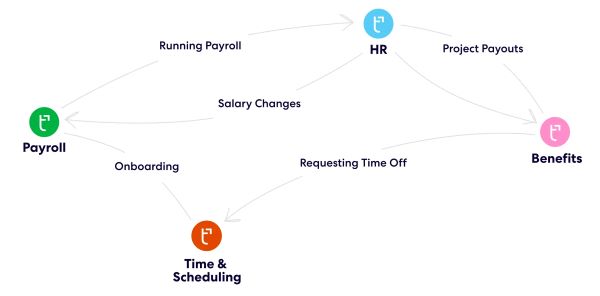
Comparison and Conclusion
Choosing between Namely and TriNet for integration and compatibility should be guided by the size of your business, the complexity of your existing software ecosystem, and your specific integration needs.
Namely is well-suited for smaller to medium-sized businesses looking for an HCM system that integrates easily with standard business applications. Its user-friendly interface and confirmed API access make it a practical choice for companies that require reliable connectivity without extensive customization.
TriNet, while capable of serving businesses of all sizes, may be particularly beneficial for organizations with more complex needs or those requiring more comprehensive HR solutions. However, the specific extent of its integration capabilities needs further verification.
In summary
Selecting between Namely and TriNet for integration and compatibility involves assessing how well each platform’s features align with your integration strategy and IT infrastructure. Namely offers confirmed third-party integrations and API access, making it suitable for SMEs. TriNet’s scalability could be advantageous for a wider range of organization sizes, though its specific integration features are less clear from the available sources. Both platforms have positive user ratings, indicating general satisfaction with their overall functionality. This decision will significantly influence your ability to achieve efficient, secure, and seamless operations across your technology stack.
Customer Support and Service
Effective customer support and service are crucial for ensuring a smooth operation and maximizing the benefits of any human capital management (HCM) system. When considering Namely vs TriNet, it’s essential to evaluate how each platform addresses customer service needs and support issues, as this can significantly impact user satisfaction and system efficiency.

Namely Customer Support and Service
Namely is known for providing targeted customer support tailored to meet the needs of small to medium-sized businesses. Its service model focuses on accessibility and user-friendly solutions, ensuring that clients can easily navigate and utilize the platform.
Key Features of Namely Customer Support and Service:
- Mobile App Accessibility: Namely offers a mobile app that allows employees to access various HR features on-the-go, including viewing paystubs, benefits, and tax documents.
- Time-Off Management: The app enables users to request and manage time off directly from their mobile devices.
- Social News Feed: Provides a platform for company updates and employee interaction, fostering engagement and communication.
- Employee Directory: Allows users to look up coworkers for instant communication, enhancing collaboration.
Namely’s customer support structure is designed to be responsive and user-friendly, making it highly suitable for SMEs that require accessible HR solutions. The platform has a high support rating of 8.0, indicating strong user satisfaction with its support services.
TriNet Customer Support and Service
TriNet provides customer support and service designed to meet the demands of businesses of various sizes, offering solutions to address a range of customer needs.
Key Features of TriNet Customer Support and Service:
- Training Options: TriNet offers both in-person training (8.5 rating) and online training (8.7 rating) to help users maximize their use of the platform.
- HR Expertise: While specific details are limited, TriNet’s background as a PEO suggests access to HR expertise as part of their service offering.
- Scalable Solutions: TriNet’s platform is designed to accommodate businesses as they grow, which may extend to their support services.
TriNet’s customer support capabilities aim to provide comprehensive support to businesses with varying needs. However, it’s worth noting that TriNet has a support rating of 6.9, which is lower compared to Namely.
Comparison and Conclusion
Deciding between Namely and TriNet for customer support and service should depend on the size of your business, the complexity of your HR operations, and your expectations for support responsiveness and accessibility.
Namely excels in providing user-friendly solutions with high accessibility. Its mobile app features, social news feed, and high support rating (8.0) make it an excellent choice for businesses looking for straightforward, accessible help. Namely also has a higher likelihood to recommend (7.5) and to renew (9.5) compared to TriNet.
TriNet, while having a lower support rating (6.9), offers valuable training options both in-person and online. It may be suitable for businesses that prioritize comprehensive training and scalable solutions.
In summary
Choosing between Namely and TriNet for customer support and service involves assessing how well each provider’s support offerings align with your company’s size, complexity, and service expectations. Namely offers responsive and user-friendly support ideal for SMEs, with strong mobile accessibility and higher user satisfaction ratings. TriNet provides training options and scalable solutions that may appeal to growing businesses. This decision will significantly influence the overall satisfaction with your HCM system and its effectiveness in supporting your HR functions.
Pricing and Cost-effectiveness
Understanding the pricing structures and cost-effectiveness of human capital management (HCM) systems is crucial for businesses aiming to maximize their HR investments. When comparing the pricing and cost-effectiveness of Namely vs TriNet, it’s important to consider how each platform’s pricing model aligns with the features they offer and the value they deliver to different sized businesses.

Namely Pricing and Cost-effectiveness
Namely offers a tiered pricing structure designed to cater to businesses of various sizes and needs.
Key Features of Namely Pricing and Cost-effectiveness:
- Tiered Pricing Model: Namely offers three pricing tiers: HR Fundamentals, HR Complete, and Enhanced Services.
- Customized Pricing: Exact pricing is not publicly available and is listed as “By request,” suggesting a tailored approach to pricing based on specific business needs.
- Free Trial: Namely provides a free trial, allowing potential customers to test the platform before committing financially.
- Feature-rich Plans: Even the basic tier (HR Fundamentals) includes features like a company news feed, employee directory, and performance management tools.
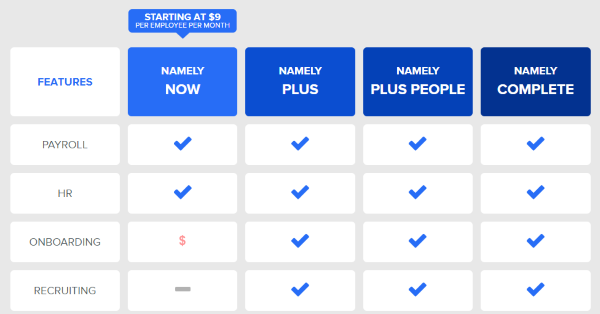
Namely’s pricing strategy is designed to be flexible and scalable, appealing to small and medium-sized businesses looking for comprehensive HR solutions.
For more information about pricing, please visit Namely’s webiste.
TriNet Pricing and Cost-effectiveness
TriNet offers a comprehensive pricing model that reflects its capability to serve businesses of various sizes with complex HR needs.
Key Features of TriNet Pricing and Cost-effectiveness:
- Customized Pricing: Like Namely, TriNet’s pricing is not publicly available, suggesting a tailored approach based on specific business requirements.
- No Free Trial: Unlike Namely, TriNet does not offer a free trial of its services.
- Comprehensive Services: TriNet’s pricing likely reflects its full-service PEO offerings, including benefits administration, risk mitigation, and payroll services.
- Scalable Solutions: While specific pricing tiers are not mentioned, TriNet’s services are designed to scale with businesses as they grow.
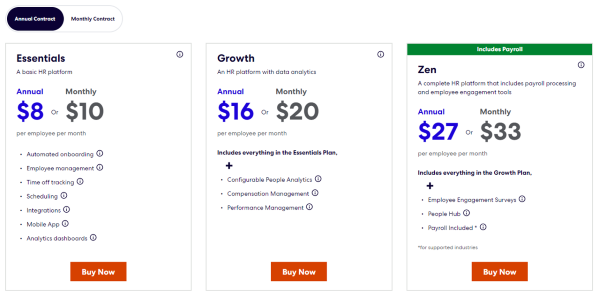
TriNet’s pricing model is designed to provide value for businesses looking for a comprehensive HR solution, though the lack of transparent pricing may make initial cost comparisons challenging.
For more information about pricing, please visit TriNet’s website.
Comparison and Conclusion
Choosing between Namely and TriNet for pricing and cost-effectiveness depends largely on your business size, the complexity of your HR needs, and your budget.
Namely offers a more transparent tiered pricing structure with a free trial option. Its flexibility in pricing and features makes it attractive for small to medium-sized businesses looking for scalable HR solutions. Namely also has higher user ratings on platforms like Trustpilot (3.5) compared to TriNet (1.6), which could indicate better perceived value for money.
TriNet, while less transparent in its pricing, offers a comprehensive suite of HR services that may provide better value for businesses needing extensive HR support. Its slightly higher iPhone app rating (4.8 vs Namely’s 4.7) suggests a good mobile user experience, which could be a factor in overall cost-effectiveness.
In summary
Deciding between Namely and TriNet on the basis of pricing and cost-effectiveness involves weighing the transparency and flexibility of Namely’s pricing against the comprehensive services offered by TriNet. Both platforms target mid-sized businesses, but Namely’s tiered structure and free trial may be more appealing for companies looking to gradually scale their HR solutions. TriNet, while potentially more opaque in pricing, might offer better value for businesses needing a full-service HR solution from the outset. Consider your specific HR needs, growth projections, and the importance of pricing transparency when making your decision.
User Reviews and Testimonials
User reviews and testimonials play a crucial role in evaluating the real-world effectiveness and satisfaction associated with human capital management (HCM) systems. When considering Namely vs TriNet, examining what users have to say about each platform can provide valuable insights into their usability, functionality, and overall service quality.

Namely User Reviews and Testimonials
Namely is favored particularly by small to medium-sized businesses, with user feedback often highlighting the platform’s user-friendly interface and effective customer support.
Key Highlights from Namely User Reviews and Testimonials:
- Positive User Experience: Namely has a Trustpilot rating of 3.5, with users praising its intuitive design and easy navigation.
- Strong Customer Support: Namely boasts a high support rating of 8.0 on TrustRadius, indicating responsive and helpful customer service.
- Effective HR Tools: Users appreciate Namely’s comprehensive suite of HR tools, including e-sign I-9 & W-4 functionality and third-party integrations.
- High Satisfaction: Namely has a high likelihood to recommend (7.5) and an impressive likelihood to renew (9.5) on TrustRadius.
Namely’s generally positive reviews often focus on its simplicity and effectiveness, making it a favored choice among SMEs looking for an accessible and straightforward HCM solution.
TriNet User Reviews and Testimonials
TriNet is typically used by medium to large-sized businesses, with reviews frequently pointing to its extensive HR capabilities and scalability as significant advantages.
Key Highlights from TriNet User Reviews and Testimonials:
- Comprehensive HR Services: Users often highlight the breadth of HR services provided by TriNet, including check delivery options.
- Mobile Accessibility: TriNet has a slightly higher iPhone app rating (4.8) compared to Namely (4.7), suggesting a good mobile user experience.
- Areas for Enhancement: TriNet’s Trustpilot rating of 1.6 and lower support rating of 6.9 on TrustRadius indicate potential areas for improvement in customer satisfaction.
- Implementation Challenges: TriNet has a lower implementation rating (2.8) compared to Namely (4.9), suggesting some users face difficulties during setup.
TriNet’s reviews often emphasize its ability to provide a comprehensive, all-in-one HR solution that supports larger businesses with complex needs.
Comparison and Conclusion
Analyzing user reviews and testimonials for Namely and TriNet shows clear trends that can help prospective users decide between the two based on their specific business needs and preferences.
Namely is well-regarded for its user-friendliness and supportive customer service, making it an ideal choice for smaller businesses within the mid-size range. It has higher ratings across various platforms and a significantly higher likelihood to renew (9.5) compared to TriNet (6.4).
TriNet, while having lower overall ratings, is favored by some larger organizations that require robust HR functionalities and expertise. Its slightly higher iPhone app rating suggests a good mobile experience for users.
In summary
Deciding between Namely and TriNet based on user reviews and testimonials involves considering the scale of your operations and your specific HR needs. Namely offers simplicity, excellent customer support, and high user satisfaction, suited for SMEs. TriNet provides extensive services that may appeal to larger enterprises, though with mixed user feedback. Both platforms target mid-size businesses, but user reviews suggest Namely may be more suitable for smaller businesses within that range. These insights can guide organizations in choosing an HCM system that best fits their operational requirements and cultural values, ensuring high user satisfaction and operational success.
Conclusion
Selecting the right human capital management (HCM) system—whether Namely or TriNet—requires a comprehensive understanding of each platform’s strengths and how they align with your organizational needs. From user interface and experience to integration capabilities and customer support, both Namely and TriNet offer unique advantages tailored to mid-size businesses.
Namely stands out for its user-friendly interface and high user satisfaction ratings. It’s particularly well-suited for organizations that prioritize ease of use and effective customer support. Namely’s platform offers features like e-sign I-9 & W-4 functionality, third-party integrations, and API access, making it a robust choice for businesses looking for a straightforward yet comprehensive HR solution.
TriNet, while also targeting mid-size businesses, offers a different set of features that may appeal to companies with specific needs. For instance, TriNet provides check delivery options, which Namely does not. However, it’s important to note that TriNet has lower overall user satisfaction ratings compared to Namely.
Making the Decision
When deciding between Namely and TriNet, consider the following factors:
- User Experience: Namely is highly praised for its intuitive design and user-friendly interface. If ease of use is a priority, Namely may be the better choice.
- Customer Satisfaction: Namely has higher ratings on Trustpilot (3.5) compared to TriNet (1.6), and a higher likelihood to recommend (7.5 vs 7.2) and renew (9.5 vs 6.4) on TrustRadius. This suggests higher overall user satisfaction with Namely.
- Features: Both platforms offer core HR functionalities like automated tax filing & payments, employee access, direct deposit, and pre-tax deductions. However, Namely’s additional features like e-sign capabilities and third-party integrations might be decisive factors for some businesses.
- Customer Support: Namely has a higher support rating (8.0) compared to TriNet (6.9), indicating potentially more satisfactory customer service experiences.
- Pricing Structure: Namely offers three pricing tiers (HR Fundamentals, HR Complete, and Enhanced Services), allowing for some flexibility. TriNet’s pricing structure is not clearly outlined in the available information.
- Mobile Accessibility: While both offer mobile apps, TriNet has a slightly higher iPhone app rating (4.8) compared to Namely (4.7), which might be relevant for businesses prioritizing mobile access.
Ultimately, the choice between Namely and TriNet will significantly influence your organization’s HR management efficiency, employee satisfaction, and overall operational success. Namely appears to have an edge in user satisfaction and ease of use, which could be particularly appealing for businesses looking for a user-friendly, well-supported HR platform. However, TriNet may offer specific features that could be crucial for certain business needs.
By carefully considering your specific requirements, the unique offerings of each platform, and the reported user experiences, you can make an informed decision that aligns with your strategic goals and supports your workforce effectively. Remember that both platforms are designed for mid-size businesses, so your choice should ultimately depend on which features and user experience best match your organization’s specific needs and preferences.
![]()
![]() Read our full Namely review
Read our full Namely review
![]()
![]() Read our full TriNet review
Read our full TriNet review

